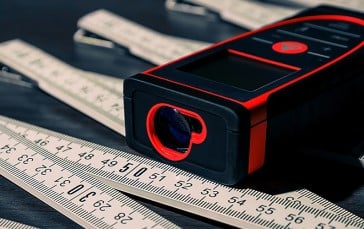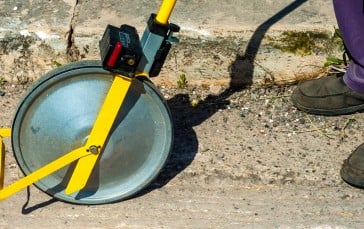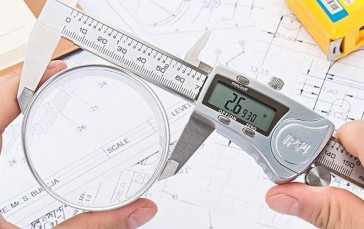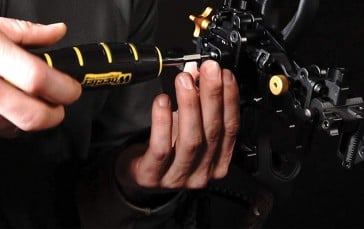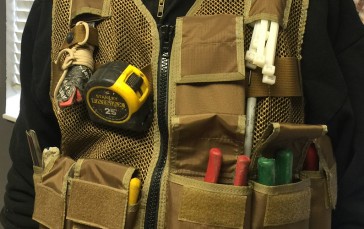ISO A Long, Stiff Tool: The Best Tape Measures in 2022
If you’ve ever worked on a jobsite, or with tools in general, you know how much a bad tape measure sucks. At best, a floppy blade or unintelligible markings limit your productivity; at worst, your cronies make fun of you and the physical frustrations still occur.
Ditch the limp tape life with the best tape measures. A stiff, proud tape measure can make a massively positive difference in any male’s life — as long as he’s healthy enough for measuring activities. The same’s true for any female in fact, or anyone sharing an intimate relationship with the tape measure user in question.
But there are a lot of options on the market — how are you supposed to figure out which one’s best for you and your lifestyle? Our in-house tool man’s here to help. He’s worked a tape measure or two in his day, from puny, often disappointing 12-footers to intimidating, girthy Stanley Fat Maxes 35 feet long or more.
The reasons to improve your measuring tape life are countless: land more jobs, increase your confidence, and impress coworkers and neighbors with the enhanced performance offered by the top tape measures. If you feel like the world of maximal tape measure satisfaction is for you, our guide and tested reviews are here to help.
- Most Automatic Tape Measure: Meterk Digital Tape Measure
- Best Overall Tape Measure: Stanley 25’ Powerlock Tape Measure
- Best Cheap Tape Measure: Craftsman Chrome Classic 25-Foot Tape Measure
- Best Fat Tape Measure: Stanley 30’ FatMax Classic Tape Measure
- Best 100 Foot Tape Measure: Komelon 6611 Open Reel Fiberglass Tape Measure
- Best Compact Tape Measure: Milwaukee 6ft/2m Keychain Tape Measure
The Best Tape Measure
1Meterk Digital Tape Measure

The Meterk digital tape measure leads with a lot of varied capability. It’s standard and metric, analog and digital, auto-locking, USB rechargeable, and has calculator and storage functions. Tool makers face two pitfalls when they cram as many functions as they can into one item: 1) quality of each function suffers, and 2) overall quality suffers.
(Tl;dr don’t buy it, unless you’re somehow into measurement masochism.)
Based on my testing, Meterk stepped in both buckets of quality issues. I’ll admit that I’m resistant to digital adaptations of job tasks you can just as easily perform with analog methods. Why do I need to shoot it with a laser and read numbers on a screen when I can just as easily span it with a tape, read the number, and mark it? And, more importantly, how do I know the laser’s giving me accurate information?
For one reason, the laser is a cool idea: making a long span across empty space with a tape measure takes skill, and sometimes it’s impossible. Laser measurement can solve the problem. Meterk takes laser capability a step further by adding a calculator for square and cubic footage.
The tape set my crusty, old-school framer hackles on end. This was an affront; I could do all this on my own, without the help of a screen or a laser. But I set my judgment aside and put the Meterk to the test by measuring a simple distance — just in case it worked.
Unfortunately, it didn’t. Here’s why:
- The laser was mounted so close to the bottom of the tool that getting a clear shot meant putting it on top of something.
- For some reason, the laser measured to the back of the tape measure. But to where at the back of the tape measure? The rubber bezel’s back edge had multiple angles. For any measurement, there should be a distinct “0” line. But the Meterk didn’t have one for the laser mode.
- The red dot on the opposite wall disappeared as soon as I hit the button to take a reading. That sucked because there would be no way to visually confirm the measurement once I’d taken it.
- Final result: given all of the above, I was left with a tape measure on top of a random spacer, showing a distance between two unknown points.
The laser’s inherent inaccuracy voided the calculator feature’s utility (and really, if you have a regular tape and a phone, you can calculate square and cube footages). Even the auto-lock was annoying. Most auto-locks still enable an automatic rewind, but the Meterk made me hold down the button to rewind it. Why should the job of rewinding a tape measure take two hands?
In a final insult, the tape was hard to read. Making one side metric and one side standard seems like a good idea until you have to use the opposite side to make the mark you want. In that case, you’d have no choice but to use a square or measure from the other end. Either way, lame. And don’t make me think about 32nds of an inch. For common uses, any tape marked with 16ths is fine; 16ths themselves are so close together that a moderately blunted pencil won’t fit between them.
Finally, why were the foot and inch markings (e.g. 1-3 for one foot, three inches) right in the middle of each inch increment? Is it 1 foot, 1 inch or 1 foot, 1 ½ inches? It would be impossible to quantify how deeply the tape’s markings insulted the engineering principles of simplicity. There’s so much there, and so little of it is useful. Read the in-depth review here.
Verdict: Two thumbs down.
Laser measuring
Auto locking
Square and cubic foot calculator
USB rechargeable
- BrandMerterks
- Blade Length16’
- Blade Width1”
- OtherLaser, Calculator, Auto-lock, USB charge
Lots of options
Imprecise, hard to use laser
Tape markings are overcomplicated
Auto-lock forces you to use both hands to extend or rewind
2Stanley 25’ Powerlock Tape Measure

You can either buy the right tool once, or buy the wrong one over and over and over again. If you equip yourself and your toolbelt with a 25’ Stanley Powerlock, you’ll keep yourself safe from that second category.
The Stanley Powerlock has been the best tape measure on the market for years or even decades. If you can remember a square, silver tape measure in the top shelf of your dad’s old tool box, I’d bet money it was a Powerlock. In my past life of trade work, I never used a tape except a 25’ Powerlock. The trades I worked in varied from house framing to window-and-door installs to building cabinets. Through it all, the trusty yellow-and-black was there to tell me where I was at.
During the decade that I “worked for a living,” so to speak, I found I had two favorite things about the Powerlock: blade quality and readability. In my experience, Powerlock tape blades folded more easily than Fat Max or Milwaukee, but never broke. I did get one or two stolen over the years, so I can’t say I’ve personally tested one for more than a few years at a time.
However, in terms of easy readability, I don’t think it gets any better than the Powerlock series. Each one I’ve had shows clearly differentiated eighths and sixteenths along the full length. The only numbers on the tested tapes were inches and feet — no irritating fractions crowding the space. Stud layout was obvious, with 16” intervals marked by red-outlined numbers and edge-to-edge arrows.
Overall effect? There was no way to mistake anything on the tape for anything else. Getting bogged down in markings that were either too close together or marked by redundant fractions was never a problem. And each one I’ve had has checked out in terms of durability, in daily use on construction sites including occasional drops on hard surfaces.
The profile of a 25-footer has been plenty narrow enough to stay out of my way. And the clips have always been tight enough to keep the tapes securely attached to pants pockets when I’m not wearing bags.
Based on years of testing experience, I can’t recommend a tape more highly than the 25’ Stanley Powerlock.
Simple setup and markings
Classic operation — no autolock, etc.
Easy to read stud layout
- BrandPowerLock
- Blade Length: 12’, 16’, 25’, 30’, 35’
- Blade Width1”
Long-term durable (as tested)
Straightforward use and reading
Narrow profile and fairly light weight
Not as much standout as fat tapes
3Craftsman Chrome Classic 25-Foot Tape Measure

Craftsman turns in a basic tape measure in the “everything you want, nothing you don’t” category: the classic chrome 25-footer. There’s startlingly little to say about the tape. If you’re looking to pay an entry-level price, it looks like a good option.
The tape uses the same easy-to-read marking system as the Stanley Powerlock on its white blade. It adds a rubber grip for easy handling, and it’s got a simple slide lock. The tip is double-sided, so you can hook it under or on top of a surface.
That’s it! The Craftsman chrome classic 25-foot tape measure should be a good basic carpenter tape measure for workers looking to save a buck. For those who need it, it also comes in an 8-meter/26-foot version. Don’t forget to also check out our list of the best laser measuring tools.
Simple marking system
Rubber grip
Double-sided tip
- BrandCraftsman
- ModelCMHT37316S
- Weight9.6 ounces
- Blade Length16’, 25’, 30’, 35’, 8m
- Blade Width1”
- OtherDouble sided tip
Straightforward
Good brand reputation
Basic
4Stanley 30’ FatMax Classic Tape Measure

The original “fat” tape measure, the Stanley FatMax has long been the high-quality tape measure of choice for workers who need durability and long standout. By adding ¼” to the standard 1” blade width, Stanley gives the FatMax outstanding, uh, standout — the brand claims 14 feet.
The grippy rubber on the FatMax case helps keep you from dropping it when your tip’s out flapping in the breeze. And the two-way tip means you can hook just about anything with it. Its markings are the classic Stanley hashmarks — differentiated eights and sixteenths, no fractions printed on the blade. Stud layout is clearly marked, and the edges are identical.
There’s only one problem with fat tape measures — just like anything fat, they’re heavier than any skinny object of the same size. From occasional field experience, I can say the FatMax is a legitimate choad. It can be easy to bump it on things if it’s clipped to your pocket. And if you’re carrying it in your tool bags, it can be an awkward fit depending on the size.
It’s not much of a knock on an otherwise solid tape measure with optimized standout. If you’re spanning big gaps, the FatMax is a solid tool for the job. It also comes in multiple variations, including metric, magnetic, and the huge 40-footer. You can even get a cute (but functional) 6’ keychain version.
1 ¼” blade
14 foot standout
Double sided tip
- BrandStanley
- Model33-730
- Weight1.18 pounds
- Blade Length16’, 25’, 30’, 35’, 40’, 8m, 10m
- Blade Width1 ¼”
- OtherDouble sided tip
Resilient blade
Good for longer spans
Wide; can feel cumbersome or heavy
5Komelon 6611 Open Reel Fiberglass Tape Measure

Komelon’s 100 foot open reel tape measure has a coated fiberglass blade for durability, and a big reel handle to make rewinding easy. It also gets a dual-purpose hook, to fit over the corner of a flat surface or around a nail.
What makes any open reel tape measure different than any other? We like the Komelon for its simple design, functional hook and ergonomic grips. The contoured carry handle and the big reel grip should help make it comfortable as you walk the long line, then wind it all back up.
The hook looks like an advantage too. You never want your tip to pop off your anchor point, and that’s especially true if there are 90+ feet between you and it.
Finally, we like the design with the posts on the central hub. 100 foot tapes tend to do a lot of dirty work on the ground. More internal space means more places for grit to accumulate.
And unless you’re measuring post holes and somehow hit it with a garden shovel, you shouldn’t have any problems making the flexible, double-coated blade last forever. For the most abrasive jobs, you can cue up a stainless steel 100-footer like this beast from Keson.
At a reasonable price point, the Komelon 100 foot tape measure looks like a winner. Feet and inches are marked on one side, feet and tenths on the other. It also comes in 200’ and 300’ versions.
100 foot flexible fiberglass blade
Dual-function hook
Contoured carry handle, big reel handle
- BrandKomelon
- Model6611
- Weight11.2 ounces
- Blade Length100’, 200’, 300’
- Blade Width5”
- OtherMulti-functional hook
Flexible fiberglass tape measures are durable
Substantial hook for security while measuring long distances
⅛” increments
6Milwaukee 6ft/2m Keychain Tape Measure

Want an EDC tape measure to keep on hand at all times? Milwaukee’s keychain tape is less than 2” square and just ¾” thick. It’s got a handy clip to attach it to any keyring/lanyard situation. Still, it measures up to six feet in metric and standard increments.
The narrow blade measures centimeters and millimeters on one edge, and inches down to sixteenths on the other. The markings are clear and non-convoluted.
That’s really all there is to it! Milwaukee makes solid tools, and we picked its keychain tape out of the pile because of the brand’s reputation for durability. Any keychain item takes some punishment from daily jostling, so it should be solidly built.
And because it’s an EDC pocket tool, increments for handling both measurement systems make sense. When you’re building something, chances are you know what increments you’re using — but for more random tasks, you might have to use either scale.
Pocket-size
Metric and standard increments
Keychain clip included
- BrandMilwaukee
- Model48225506C
- Weight0.79 inches
- Blade Length6ft/2m
- Blade Width¾”
Easily pocketable
Versatile between metric and standard systems
Short! Don’t use it for big projects
Why Trust Us
To borrow a phrase, our man has spent most of his construction life livin’ in a tape measure paradise. But he’s also walked through the shadow of the valley of tape measure death, taken a look at his life and realized there was nothing left.
He doesn’t want a floppy blade any more than you do, trust me. Anything’s better than extending your tape for a satisfying, attention-grabbing span and watching it fold over, limp as a tube sock. Any project is better with the right tool in hand; tape measures are no different.
Who This Is For
The workers of the world, man. This ain’t no tape measure guide for 1%-ers, low orbit cosplayers or those who just look puzzled when the second thing you tell them about someone is that they have “dirt under their fingernails.”
Instead, I’m writing it with dirt under my fingernails. Because you can take the worker out of the work, but you can’t take the work out of the worker.
How We Picked
A ton of brands make tape measures, so it can be hard to figure out which one’s right for you. We included a few classics and a few new-school entries to give you the view from 25 feet, so to speak. There’s even a hundred-footer and a weird digital version in here.
How We Tested
Easy; pick some cheap tape measures and tear them apart. Pick some techy, futuristic tape measures and tear those apart. Then pick some classic, time-tested tape measures and try to tear them apart. Measure twice, cut once. Observe results and report.

Features To Look For In Tape Measures
Accuracy — For tape measures, accuracy is only as good as the user’s level of comfort with the tool in their hand. Maybe you prefer a big, sturdy tape. Maybe the situation calls for a more delicate approach. Maybe you like a zillion increment markings, or maybe you’re more comfortable with eights and sixteenths. If you’re a simple kind of man (to borrow a phrase), look for something that won’t offend your simplistic sensibilities. If you need to measure tolerances for intricate machining, get something a little more refined.
Durability — I’ve personally dropped a 25-foot Stanley Powerlock off a second-story wall plate onto a concrete slab without breaking it. By the same token, I once broke a Wal-Mart-status cheap tape measure by forgetting it was on my belt and sitting on it (true story). It’s tools, kids: more often than not, you get what you pay for.
Clip design — Must be comfortable to wear. You’re never gonna measure anything if you have to call your tape like a dog every time you need it. The best clips help you pocket tape measures, keeping them comfortably within arm’s reach and taking up no pocket space.
Even if you wear tool bags every day, don’t get a tape with a flimsy clip — or one that’s got an annoyingly wide profile. Chances are you’ll still use the clip sometimes, and you don’t want it to be either useless or in the way.
Readability — Critical. I’m in that cro-magnon faction of stubborn framing carpenters who still call sixteenths “little eighths,” so I absolutely require a tape with straightforward markings. I also hate when fractional hash marks are actually numbered on the blade, e.g. “⅛, 3/16, ¼” etc. If I needed to remind myself of the difference between an eighth and a quarter every time I looked at my tape measure, I would have died of crippling mental fog long ago.
Whatever your preferences, bottom line: blade markings should be pronounced, consistent, and easily distinguishable from each other.
Standout and throw — If you’re trying to make a big span, you’re gonna need a lot of standout. There’s no two ways about that, unless you want to task your buddy with grabbing your tip and walking across the room with it.
But hey, we’re not here to criticize anyone else’s lifestyle. This is about tape measures. Another thing associated with standout is throw — if you grip the end of the tape and huck it as far as you can, how many inches (or feet?) can you get out of it?
Maxout contests for standout and throw are typical games at construction sites, and commonly become measurements of an individual’s prowess. What’s the point, other than the eternally fascinating question of “how long is yours?” None; there’s almost always a way to measure what you’re trying to measure without tape measure theatrics. Showing off is the main utility.
Hook design — A standard hook is a simple L shape and fits over the corners of most square surfaces. Simple; the only innovation is usually a slot, cut out of the hook to help you fit it over a nail head. Fat Maxes and other big tapes can have massive, multi-directional hooks. We asked our tool guy what he thought about the plus-sized, innovative hooks seen on big new-school tape measures. He said “those are dumb.”
That was that. We had to push back a little on that one; the ability to use your hook at any orientation can be pretty cool. And he did say it’s sometimes helpful to have a magnetic hook. Just don’t keep it in the same bag you keep your trim nails in.
Ergonomics — You may think of yourself as a big, tough, self-reliant homemaker, technician or pro. Hell, you may very well be, and you probably are, compared to me. On those grounds, you may not think you should give a steamy pile about ergonomics in your tape measure.
But you should. If it’s uncomfortable — too heavy, too awkward, etc. — you’ll start to notice it. Using it every day will just amplify any of its irritating qualities. Been there, done that; and you don’t wanna do it, no matter how rugged you are.
Price and value — Simple enough: spend money. Don’t expect a precision tool to be worth the trouble if you pay a below-market price for it.
Weight — Some tapes are too heavy to be comfortable to use. Some are too light-duty to perform the job at hand. If your tape’s too heavy, you’ll notice it all the time and it will annoy you. It may have a pocket clip, but you’ll never use it if you can’t keep your pants up while it’s on your pocket. Conversely, a lightweight tape can’t do everything. Try making a 12 foot tape stand out 12 feet — if you can do it, take a video and send in for an award of some kind. Perhaps a very long, flimsy trophy.
Locking mechanism — Casual amateur's perspective first: every tape measure has a lock of some kind, so you can lock the blade in place and walk away from the tape. Should it engage automatically? Maybe, if you're just getting used to the idea of using a tape measure or happen to be differently abled. Still, consider buying a tape with a manual lock. You'll get used to the tape's action before long, and it will probably seem like an auto-lock makes you do an extra step for no reason.
Crusty framer's perspective second: the lock needs to work, but it shouldn’t engage automatically. Not only are automatic tape measures unnecessary, they also slow you down and teach you bad technique. If it’s the end of your day and you’re slinging crow’s feet hard and fast to finish on time, the last thing you need is an auto-lock hanging you up between every measurement. And once you get used to holding the tape open with one hand (first week on the job), there’s no reason for an autolock.
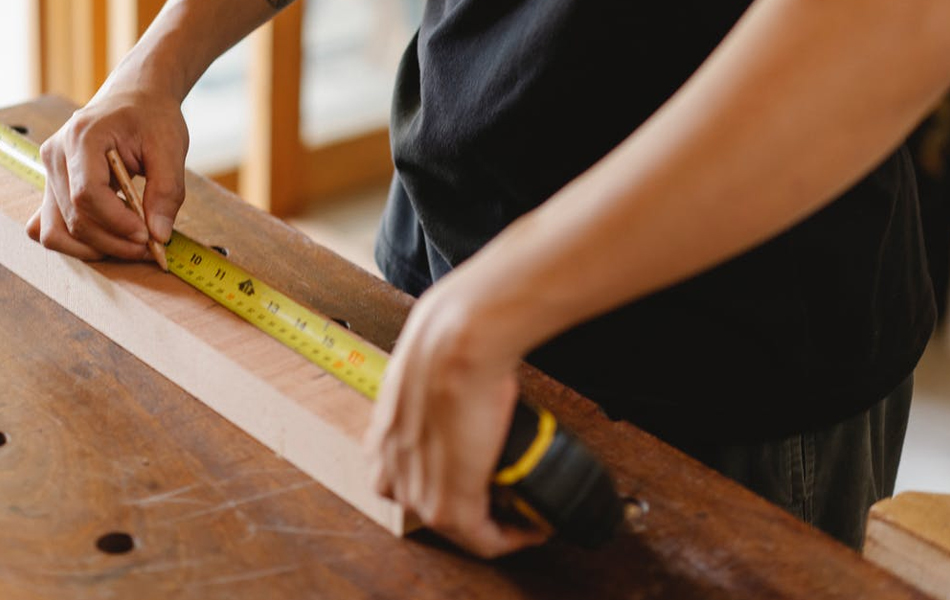
Tape Measure FAQ
Q: What are tape measures used for?
A: You can use a tape measure to measure just about anything shorter than the tape. If you get a good tape measure, you can look forward to measuring items not limited to, but including, 2x4’s, spans between walls, heights and widths of walls, diagonal distances like the hypotenuse of a triangle, the circumference of circles or any measurement across an oval or polygon or any kind, up to and including the distance between two random points anywhere in the universe if you had a long enough tape measure, the distance between your bedroom and your TV, the TV itself, your bed, anything in your bed (errrr…), and even household items like cutlery, chemical spills, your cat’s litterbox and your cat, and even our favorite everyday items like CD’s, forklifts, cans of Truly and HARD MTN DEW, computers and even gas stations. About the only thing you can’t measure with a tape measure is your own life satisfaction. But some mysteries of our realm must endure — else we would never conceive new systems to try to measure them with.
Right?
Q: Are tape measures accurate?
A: Yup — categorically. In fact, teams of metrologists (scientists who study measurement) perform pretty fascinating experiments to calibrate tape measures (see "Sources," below).
On most tape measures, the hook shifts between 1/16 and ⅛ inch to compensate for whether it’s being pushed or pulled.
When you get a new one, you can always check it against a tape or ruler you know to be accurate.
Q: What makes a good tape measure?
A: The eye, or in this case the measuring techniques, of the beholder. A tape measure should be easy for the user to use, whatever that looks like. Some will choose a small tape measure with a narrow blade for measuring fabrics or minute distances. Some will want a burly, simple tape for construction work. Still others might need a hundred-footer for shooting the arrow down a fence line. But as long as you know what you’re looking at when you whip out your tape, you’re headed in the right direction.
Q: Are all tape measures the same?
A: Nope. I’ve had two of the same exact tape (same brand, same designation, same length) at the same time before, and liked one better than the other. Different tapes do different things well. You could have one that’s really only handy for long distances, and one that’s only three feet long but measures increments in 1/32 of an inch.
Q: Why is a tape measure curved?
A: For rigidity and accuracy. The curve helps standout because the cross-sectional shape is more resilient than a flat line. That, in turn, makes the tape resilient over time. It can (and will) fold over repeatedly and still spring back into shape.
The curve also helps you mark accurately. Because only part of it touches whatever surface you’re measuring, you can turn the blade toward you more easily than if it were flat.
Q: What is the red dot on a tape measure?
A: The little red dot or diamond markings occur every 19.2” on a tape measure. That’s a little weird considering a tape measure represents distance in fractions (not in decimals). But there’s a method to the madness.
The dots exist to underpin the world of engineered trusses in framing carpentry. You can use trusses for floor joists or rafters, and they're stronger than dimensional lumber. For our purposes, there’s no reason to fully unpack that. It’s just important to know that, like many things in the construction world, the 19.2” system is based on the length of an 8’ sheet of plywood (96”). 19.2 x 5 = 96, meaning you can use the diamonds to lay out five engineered trusses over the length of a sheet.
Q: Why is the hook on the end of a tape measure loose?
A: To compensate for whether it’s being pushed into a surface or pulled against a surface. It’s pretty hard to wrap your brain around that, but it’s true. The reason it moves is to make up for the thickness of the hook. Watch this YouTube video for a detailed, and oddly enthusiastic, explanation.
Q: Why are tape measures yellow?
A: For high contrast and easy reading.
Sources:
- Truss - Wikipedia
